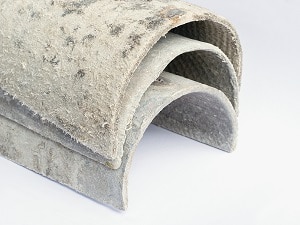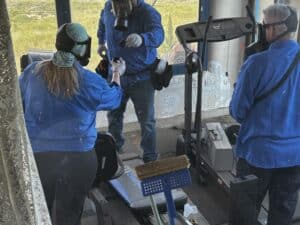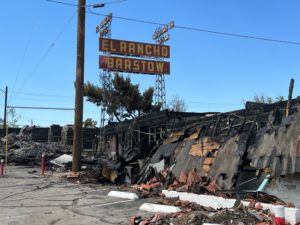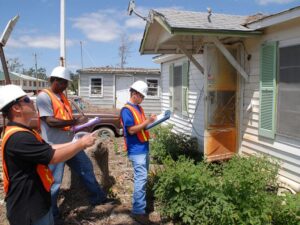Best Practices for Safely Managing Asbestos in Place

As the U.S. Environmental Protection Agency moved last month to begin the process of prohibiting the last known form of asbestos still being imported into the U.S., the challenges for the construction industry are far from settled.
The agency’s proposed rule would prohibit the importation, use or manufacturing of chrysotile, commonly known as “white asbestos” and used in the making of roofing materials, textiles, cement, and automotive parts including brakes, friction products and gaskets.
The proposed rule also includes new disposal and recordkeeping standards aligned with Occupational Safety and Health Administration (OSHA) requirements, the Asbestos National Emission Standards for Hazardous Air Pollutants (NESHAP) and industry standards, according to the EPA’s news release.
The proposal is “the first-ever risk management rule issued under the new process for evaluating and addressing the safety of existing chemicals under the Toxic Substances Control Act (TSCA)” enacted in 2016, the release says.
But the proposal is still far from a complete ban on asbestos, which remains ubiquitous in buildings constructed before 1980 and is still routinely found in buildings constructed afterward.
Chrysotile in fact, remains “the most commonly used variety of asbestos, comprising 90 to 95 percent of asbestos used in buildings in the United States,” and accounts for the majority of cases of mesothelioma and other asbestos-related diseases, according to the University of Pennsylvania’s Penn Medicine cancer center website. It is found in roofs, ceilings, walls, and floors.
Safe and Effective Asbestos Management
The EPA is separately “evaluating legacy uses and associated disposals, other types of asbestos fibers in addition to chrysotile …” according to the release, but there is no blanket mandate to remove asbestos-containing materials (ACM) from schools, offices, or commercial buildings. In the EPA’s “Guidance for Controlling Asbestos-Containing Materials in Buildings” (EPA 560/5-850024, June 1985), the agency states:
“The presence of asbestos in a building does not mean that the health of building occupants is necessarily endangered. As long as asbestos-containing material (ACM) remains in good condition and is not disturbed, exposure is unlikely. When building maintenance, repair, renovation or other activities disturb ACM, or if it is damaged, asbestos fibers may be released creating a potential hazard. Although not required to do so by federal law, the prudent building owner will take steps to limit building occupants’ exposure to airborne asbestos.”
Asbestos-containing products are subject to numerous environmental, health, and manufacturing regulations. EPA’s Asbestos Hazard Emergency Response Act of 1986 (AHERA) established strict regulatory standards for monitoring of asbestos in schools and was expanded to an industry standard for the management of asbestos in a variety of commercial and industrial settings. The Asbestos School Hazard Abatement Reauthorization Act of 1990 expanded accreditation requirements in the Asbestos Model Accreditation Plan (MAP) to cover asbestos abatement projects in all public and commercial buildings in addition to schools.
“Having a well-managed asbestos Operations and Maintenance plan and the expertise to carry it out is a critical step in undertaking the renovation of any building where there are asbestos containing materials.” –Omega President and Project Director Steve Rosas.
Undisturbed and undamaged, asbestos-containing material typically does not pose a health risk. However, once disturbed or damaged, microscopic asbestos fibers can become airborne, which may cause serious health problems including respiratory diseases such as mesothelioma and lung cancer in those who are exposed.
“Having a well-managed asbestos Operations and Maintenance (O&M) plan and the expertise to carry it out is a critical step in undertaking the renovation of any building where there are asbestos containing materials,” says Omega President and Project Director Steve Rosas.
ACMs are commonly disturbed during construction-related activities including renovation or demolition of a facility built with ACMs, however, exposure can be minimized by utilizing certified asbestos professionals and licensed abatement crews to perform and oversee any asbestos-related activities including repair, encapsulation, enclosure and removal work. Minor disturbance can also occur during routine cleaning, floor buffing, and other maintenance activities.
When a structure has existing asbestos-containing building materials in good condition, implementing an O&M program is an acceptable way to manage ACMs prior to their removal during demolition or renovation. A proper O&M plan is designed to manage asbestos in place to minimize exposure to building occupants, reduce the potential for disturbance of ACM, describe adequate respiratory protection for those in contact with ACMs, and to document the use of the O&M program within the building.
Safe Planning for Handling Asbestos in Good Condition
The first step in a comprehensive asbestos management plan is to conduct an asbestos assessment to identify the different types, quantities, and locations of ACMs present in the building.
A fully developed asbestos operations & maintenance plan includes awareness training for occupants and workers, with additional training for engineers, plumbers, electricians and others (vendors) who may come into contact with asbestos in the course of their work.
The Environmental Protection Agency recommends that a proactive O&M program be implemented in locations where ACM has been identified but will not be removed immediately.
A properly designed O&M program includes specific procedures for managing different types of ACMs: surfacing materials such as decorative ceiling plaster; thermal systems insulation applied to pipes, boilers, tanks and ducts; and miscellaneous materials containing asbestos such as floor tiles, textiles, siding and roofing materials.
The Right Partner for Safe and Effective Asbestos Management
At Omega Environmental, we have decades of experience in the assessment and remediation of asbestos for clients that include both private and government property managers in a variety of industries. We have developed numerous site-specific asbestos O&M plans for the safe management and removal of asbestos from high-rises, entertainment venues, and universities, among other locations.
Our team includes California Certified Asbestos Consultants (CACs), Certified Site Surveillance Technicians (CSST) and EPA-certified trainers and asbestos exposure mitigation specialists with deep expertise in the safe, cost-effective and thorough management of asbestos in buildings.
Give us a call or click on the link below to learn more about our services for asbestos assessment, management and remediation.










